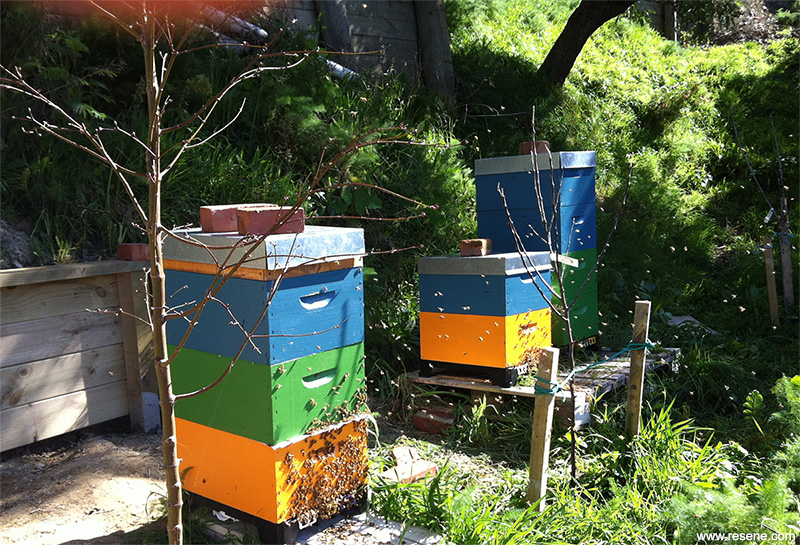Colourful beehives
Ever wondered why beehives are painted in so many different colours? Surely it would be simpler to paint hive boxes all the same colour?
Some beekeepers do this, but there is logic behind the odd collection of colours. Bees see colours well. They see a higher spectrum than we do, from yellow through to ultra-violet, though they interpret them quite differently – for example, it is said that bees see red as black. Ultra-violet, which is invisible to humans, is handy for the bees as it penetrates the clouds allowing the bees to orient their flights paths to where the sun is in the sky even on a cloudy day.

Beekeepers try to keep the populations of their hives consistent in number. If all the hives are painted the same colour and lined up in a straight row, it’s easy for the bees to enter the ‘hive next door’ by mistake when returning home with a stomach full of nectar or pollen baskets on their legs filled with pollen. The hive bees will accept the stranger and they will become part of the colony. This bee phenomenon is known as ‘drifting’.
This mistake keeps happening until, at the end hive, there’s no hive next door so it’s obvious to the bee that they are at the right place. The effect of this is that gradually the centre hives’ populations become depleted and the end hives have high numbers of bees.
When this happens the end hives will produce a large crop during the honey flow but the middle hives will not because there are not enough field bees in the colony.
There are ways the beekeeper can help the bees find their way back to the correct hive. If the hive entrances are oriented at different angles to the sun the bees know they are heading for the right hive because the sun’s angle is right (remember the ultra-violet penetrating the clouds). If rocks or other objects are placed near some of the hives the bees use them as reference points to find the right hive.
If the hives are not all painted the same then the returning bee can discern the shades of colour their hive has and is unlikely to make a mistake.
Mistint paints are popular with beekeepers. If they have many boxes to paint they can start with some Resene paint in a bucket, paint a few boxes then tip a little of another Resene mistint colour into the bucket resulting in a different shade, paint some more, then add in another colour.
As the Aoteabeeman says “It’s quite fun seeing what results. At the end I’ll finish with twenty five or so different shades, making it very easy to mix up my colours in the field.”
Supplied courtesy of the Aoteabeeman.
Photos by Nick Mouat.
From the Resene News – issue 3/2014
Resene case studies/awards project gallery
View case studies that have used Resene products including many from our Resene Total Colour Awards. We hope these projects provide inspiration for decorating projects of your own...view projects
Total Colour Award winners:
2023 |
2022 |
2021 |
2020 |
2019 |
2018 |
2017 |
2016 |
2015 |
2014 |
2013 |
2012 |
2011 |
2010 |
Entry info
Latest projects | Project archive | Resene news archive | Colour chart archive
Order online now:
Testpots |
Paints |
Primers and Sealers |
Stains |
Clears |
Accessories
![]() Get inspired ! Subscribe
Get inspired ! Subscribe ![]() Get saving ! Apply for a DIY card
Get saving ! Apply for a DIY card
Can't find what you're looking for? Ask us!
Company profile | Terms | Privacy policy | Quality and environmental policy | Health and safety policy
Colours shown on this website are a representation only. Please refer to the actual paint or product sample. Resene colour charts, testpots and samples are available for ordering online. See measurements/conversions for more details on how electronic colour values are achieved.
What's new | Specifiers | Painters | DIYers | Artists | Kids | Sitemap | Home | TOP ⇧
